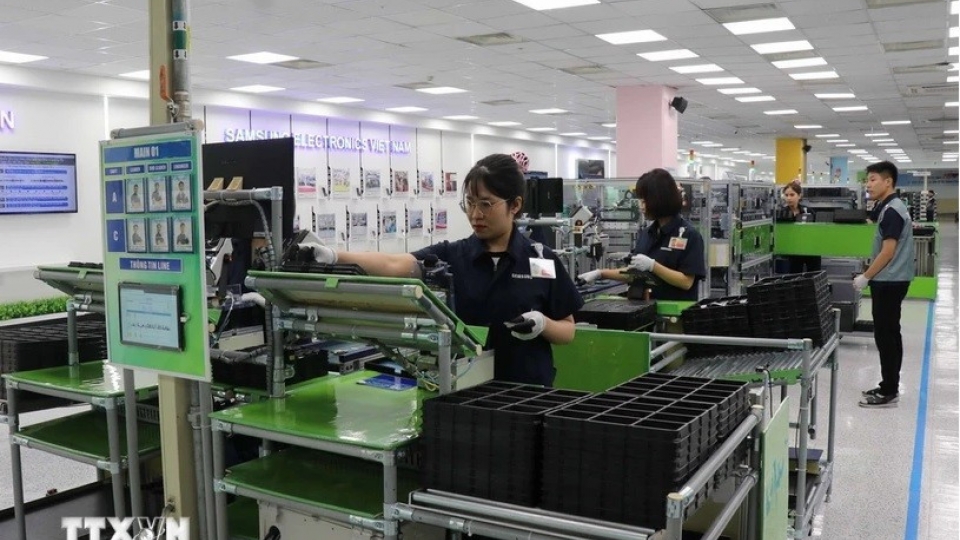Vietnam emerges as ASEAN’s top next-generation trade hub
VOV.VN - Singapore’s newswire the Business Times recently published an article highlighting Vietnam as ASEAN’s top next-generation trade hub, showing the country’s resilient manufacturing and robust export growth.

The media outlet outlined that Vietnam’s growing competitiveness relative to other countries in the region is helping to fuel its rise as one of the top global manufacturing powerhouses.
The country’s position was recently bolstered by its ranking as the second-most promising next-generation trade hub – behind the United Arab Emirates – in a report released on November 5 by Allianz Research.
The Germany-headquartered trade analysis team credited Vietnam’s rise to its surging exports and a new tariff agreement with the US, which solidifies its role at the centre of Asia’s manufacturing re-route.
The report pointed out that the country’s increasing number of free trade agreements, lower labour costs, and diversified export basket have all contributed to its growing influence.
In addition, Vietnam is benefiting from broader regional shifts, such as the offshoring of manufacturing from China and the regionalisation of trade.
Indeed, despite a challenging global economic environment marked by rising tariffs, shifting supply chains, and geopolitical tensions, Vietnam’s export sector has remained resilient.
Merchandise shipments rose 17.5% year on year to US$42.1 billion in October, according to the recent preliminary data provided by the Vietnamese government’s statistics body.
In the first 10 months of 2025, Vietnam’s total exports and imports climbed 16.2 % and 18.6 %, to US$391 billion and US$371.4 billion, respectively.
However, on a month-on-month basis, merchandise exports last month contracted by 3.5 % in seasonally adjusted terms, a sign that the effects of higher tariffs from the US are beginning to have a more pronounced impact on Vietnam’s economy.
Adam Ahmad Samdin, an economist at Oxford Economics, noted that export growth next year is still at risk of further drags from the possibility of the US’ additional sectoral tariffs and the lack of clarity around the definition of “transhipment”.
However, he said the impact of tariffs could also be partially offset by sustained demand for artificial intelligence-related infrastructure, which is expected to continue into 2026.
Meanwhile, Vietnam’s manufacturing sector showed signs of strengthening at the start of 2025’s fourth quarter. In October, the Vietnam Manufacturing Purchasing Managers’ Index (PMI) from S&P Global rose sharply to 54.5, from 50.4 in September.
This marked improvement reflects accelerated growth in output and new orders, especially with a pickup in new export orders for the first time in a year.
Tourism has been another bright spot for Vietnam’s economy this year. International arrivals surged by 22.1 % year on year to 1.7 million in October. This follows a 19.5 % rise in September and reflects growing interest in Vietnam as a tourist destination.
“Tourism should continue to support domestic spending,” said Oxford Economics’ Samdin, though he believes momentum in private consumption has peaked, since inflation-adjusted wage growth has slowed.
According to the report, Vietnam’s inflation rate eased to 3.25 % in October 2025, down slightly from a three-month high of 3.38 % in the preceding month.
Disbursed investment from the state budget in October surged by over 29 % year on year, maintaining the strong momentum seen in Q3.
Meanwhile, the ongoing 10th session of the National Assembly has proposed a fiscal deficit of 4.2 % of gross domestic product for next year, up from 3.1 % in 2024, signalling a firm commitment to increasing spending to drive economic growth.
Foreign investment is also flowing into Vietnam at a rapid pace. From January to October this year, foreign direct investment (FDI) increased by 8.8 % year on year, reaching US$21.3 billion – the highest level for any 10-month period since at least 2007.
Additionally, FDI pledges, which represent future inflows, grew by 15.6 % to US$31.52 billion, indicating strong investor confidence in Vietnam’s long-term economic outlook.




